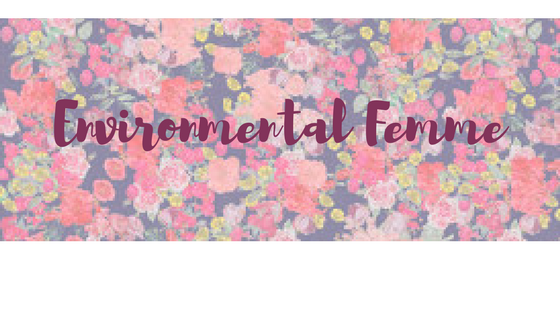(Femme)inism 101
My environmentalism post was a beast so I promise to make this introduction to the importance of feminism more brief. Also I’ve tried to write this post like four times and it just keeps ending in rants, so I’m going to challenge myself to just get the basics out there.
The goals of this post are to:
1. Demystify feminism a bit if you’re not familiar with it.
2. Explain why this blog has a femme-centric approach to environmentalism.
3. Question what kind of content you as a reader would like to see in regards to environmental, feminist, and ecofeminist issues.
So, let’s get some definitions, let’s get on the same page, and let’s go.
Definitions:
Feminism—a sociopolitical movement that combats sexism, the cisheteropatriarchy, and the devaluing of femme people and labor.
Femme--for the purposes of this blog, a femme is someone who identifies with the word femme. I’m not the identity police so do what you will. (Autostraddle did a really good roundtable on the word and its origins in Black queer communities if you want to read more!)
AFAB—assigned female at birth; a doctor looked at this person and said ‘that is a girl.’ AFAB people commonly have some combination of a uterus/clitoris/vulva, but not always, and that says nothing about their gender identity.
AMAB—assigned male at birth; a doctor looked at this person and said ‘that is a boy.’ AMAB commonly have some combination of a penis and testicles, but not always, and that says nothing about their gender identity.
Woman—someone who identifies with the gender identity of woman; can have any sort of genitalia; can be AFAB or AMAB.
Man—someone who identifies with the gender identity of man; can have any sort of genitalia; can be AFAB or AMAB.
Non-binary person—someone who does not identify as either a man or woman.
Cisgender—someone who identifies with the gender they were assigned at birth; an AMAB person who identifies as a man and an AFAB person who identifies as a woman.
Transgender—someone who does not identify with the gender they were assigned at birth.
Misogyny--gendered oppression that holds masculinity as superior to femininity; perceives femininity as weakness and threatens its existence with violence.
Transmisogyny—the specific form of oppression experienced by trans women, non-binary femmes, and some AFAB people.
Misogynoir—the specific form of oppression experienced by Black women and femmes.
Disclaimer: Gender is really personal and we are all allowed to relate differently to words, to ideas, to the process of discovering who we are. Terms are only so helpful; people connectto them in many different ways, and sometimes don’t fuck with them at all. Take the words that feel good to heart, challenge those that don’t. Call people in, care about their personhood.
So, if everyone experiences gender really differently and has different feelings about words, then why celebrate femmehood? Why is that good for everyone?
Well, folks, even though people experience gender differently, the existence of gendered oppression affects everyone—definitely some more than others. When we think about the most affected--queer women, AMAB femmes, trans women, trans women of color—there is so much violence and hatred directed at these identities. Celebrating them becomes an act of resilience. To this day I work through my own internalized sexism and part of what helps me do that is owning the parts of myself the world would like me to be ashamed of. It was revolutionary for me when I began to feel my own fragility as power. I want to be unapologetic in my femmehood—meaning my embodiment of my self-indulgence, empathy, and love for community. Being femme, for me, is these things and so much more. It’s glitter, wearing skirts when it’s dangerous, having sharp nails ready to be used against catcallers, loving fat people and how they look, fighting for my sisters in all forms, and still more. And because people claim this identity in diverse and multifaceted ways, I want this blog to be a place that celebrates all expressions of femme identity and its reclamation. Especially by fat femmes, disabled femmes, femmes of color, genderqueer femmes, poor femmes and all the femmes who rep the identity among their many others.
This is a lot to digest and I want it to be more of the start of a conversation rather than a single piece, so I’ll end with some bullets on some femme things I want to explore here and please continue your lists in the comments below:
Femme things near and dear to me:
1. Expectations of womanhood and performativity
2. Navigating consumption culture as a perceived consumable object
3. The necessity of intersectional feminism
4. Acknowledgement of us saavy poor femmes who do it better on a budget
5. The empowerment of women and femmes in environmentalism aka ecofeminism
6. The empowerment of women and femmes and especially women + femmes of color into outdoors-y, camping, hiking, nature survivalist spaces that are dominated by white men. (Isn’t the dream just femmes with power tools building greenhouses on the farm?)
7. Power of the unacknowledged emotional labor demanded of femmes
8. Mermaids. Everything mermaids forever
I am femme and proud, I am open to learning and expanding, I will dedicate my life to honoring the importance of femmes and recording here all our intricate and nuanced existences. I want to hear your thoughts.
